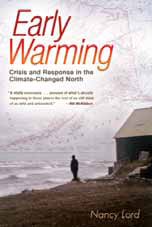SEJournal Online is the digital news magazine of the Society of Environmental Journalists. Learn more about SEJournal Online, including submission, subscription and advertising information.

BookShelf
Early Warming: Crisis and Response in the Climate-Changed North
By Nancy Lord
Counterpoint, $26
Reviewed by JENNIFER WEEKS
Alaska’s official tourism website touts the state’s stunning scenery, outdoor activities and historic sites under the header “Find Your Alaska.”
Writer Nancy Lord has spent years doing just that as a commercial salmon fisherman, a natural historian on adventure cruise ships, and the state’s writer laureate.
In Early Warming, she examines how climate change is altering Alaska, neighboring regions, and the lives of indigenous people who live there.
Global temperatures are rising worldwide, but the effect is stronger at the poles.
That’s mainly due to a positive feedback loop between rising temperatures and shrinking ice and snow cover. Ice and snow reflect the sun’s rays back into space, but melting exposes darker earth and water, which absorb solar heat. That causes more warming, which causes more melting.
Alaska is warming dramatically: In the past 50 years, year-round average state temperatures have risen by 3.4 degrees Fahrenheit, and average winter temperatures have increased 6.3 degrees. That matters, Lord argues, because “what happens in the Arctic doesn’t stay in the Arctic. The polar regions function as the cooling system for our planet.”
As the climate and environment of the North change, so will the climate and ocean systems that regulate the entire world.
What’s more, as lower latitudes warm, impacts occurring in Alaska will move southward.
Lord finds many impacts during her travels that can be attributed to climate change.
Stream temperatures on the Kenai Peninsula are rising above state standards for spawning and rearing salmon. Lakes and wetlands are drying up, and fires are spreading more widely as the landscape becomes less damp. Birds are wintering farther north. Coastal erosion is intensifying as permafrost thaws and sea ice retreats from shore, exposing beaches and bluffs to wave action.
Lord also describes conservation efforts, especially work by indigenous people in Alaska and Canada’s Northwest Territories. Climate change is altering subsistence lifestyles in many ways: for example, weather patterns are harder to predict, and fishing grounds are shifting.
Lord finds some creative adaptations, such as a community garden in Fort Yukon designed to take advantage of lengthening growing seasons, and a proposal to create a sustainable wood biofuel program there to replace diesel fuel.
In a region where survival is a much bigger daily concern than climate change, initiatives such as this make sense; they help people adapt to new conditions and also make their lifestyles more sustainable.
In her most interesting chapter, Lord visits Shishmaref, a village on a small island off Alaska’s northwest coast that is slowly being eroded by storm waves.
Global print and broadcast stories have covered Shishmaref’s dilemma: The community voted in 2006 to move to a site on the mainland, but has not figured out how to pay for it (the Army Corps of Engineers estimated the cost at $179 million for 142 households). Former Vice President Al Gore has called Shishmaref’s residents “the first climate refugees.”
Climate change is magnifying much broader problems that affect Shishmaref and other marginal communities around the world. Those issues, Lord writes, “were tied to all kinds of environmental, social, and cultural changes. Perhaps above all, they were economic — the costs of energy, a lack of jobs and job skills, the challenge of trying to live modern lives without an economic base.”
Alaska is taking a laissez-faire approach: Communities can move if they want, but the state has not committed to keeping communities together or helping them maintain their cultures. But as Lord points out, if Alaska can figure out how to help impacted communities relocate and create more sustainable lifestyles in the process, it could create a model for other parts of the world.
Lord writes fluidly about climate change impacts and Alaskan landscapes, but her focus tends to wander.
This book is partly a science report, partly a travelogue, and partly a meditation on the fate of indigenous people (she clearly cares deeply about this issue, but rhapsodizes about the richness of indigenous culture and subsistence lifestyles a few too many times.)
She doesn’t provide any dates for her trips, some of which date back at least as far as 2008, and sometimes the time frame changes abruptly forward or backward.
It also would have been nice if the book included some color photos of the phenomena Lord describes, such as the light-green rings of new plant growth around shrinking lakes that she sees from an airplane (there are a few small black and white photos at the beginning of chapters, but no captions linking them to the narrative.)
Lord is a good guide, but more showing and less telling would make her story even more powerful.
Jennifer Weeks is a Boston-based freelance writer and an SEJ board member.
* From the quarterly newsletter SEJournal, Summer 2011 issue.












 Advertisement
Advertisement 



